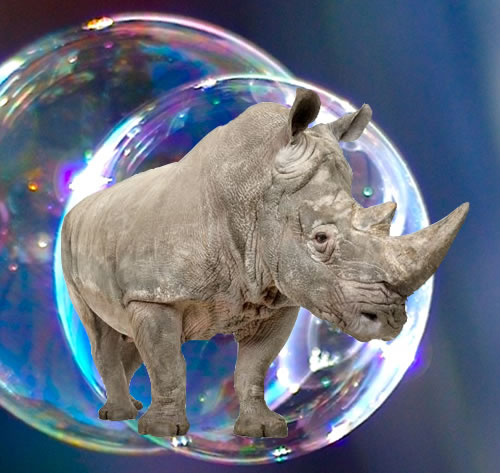
Supporters of South Africa’s push to legalize rhino horn trade are fond of saying that the position is one of economics — but expert scrutiny reveals that the “rhino-nomics” theory is simplistic, flawed, and based on naïve textbook concepts.
Speaking at the International Wildlife Trafficking Symposium in London, Dr. Alejandro Nadal — Professor at the Centre for Economic Studies of El Colegio de Mexico and Co-Chair of TEMTI-CEESP-IUCN — opened his presentation by stating that any debate on wildlife trade policy “needs to take into account the fact that markets do not behave in accordance to the simplified narrative of textbook economics”.
“What passes for economics in wildlife trade literature avoids several serious conceptual and empirical questions.”
In what he described as “the canonical model” in favor of legal wildlife trade, Dr. Nadal pointed to the typical line of reasoning proffered by pro-trade advocates: Trade bans drive supply and demand underground, prices increase in highly profitable markets; demand is stable and difficult to change; prices are high and demand is price inelastic; legal markets can take control of supply and drive prices down; lower prices eliminate incentives for ‘poaching’; property rights need to be established; legal markets are more efficient than “command control systems”; and revenues can be reinvested in conservation.
Following the examination of 25 years worth of literature relating to the wildlife trade, including both “grey” and peer-reviewed publications, Dr. Nadal determined that the literature is centered around two common approaches: partial equilibrium analysis and comparative statics. “They are both very misleading,” says Dr. Nadal.
“Flawed analysis will lead to the wrong policy options.”
This canonical model in favor of legal markets is based on what Dr. Nadal calls the “seven capital sins” of the endangered species trade literature. He emphasizes that while each problem on its own is enough to warrant a “thorough revision of methodology”, the wildlife trade literature shares all seven sets of problems.
The ‘seven capital sins’ of the endangered species trade literature:
1. Partial equilibrium. Since this model only considers one commodity in one market, there is no way to really know the price. For example, if commodity prices are falling at different rates, prices that appear to be decreasing are in fact increasing in relative terms. “Poaching incentives have to be analyzed in terms of opportunity costs, and you have to bring in the entire spectrum of prices in the entire economy, and not just one market.”
2. Comparative statics. Endangered species trade literature relies on comparing equilibrium positions only and fails to provide information about how markets and agents perform outside of equilibrium. “We don’t know anything about how markets reach equilibrium, so this is a very dangerous methodology.”
3. Supply chain. Supply chain management and optimization are central to production, yet supply chain analysis is missing from most wildlife trafficking studies. “These are illegal markets, but still, we need to incorporate that into the analysis of price formation.”
4. Multiproduct firms and scope economies. Multiproduct firms have the advantages of lower distribution costs associated with product diversification, and production cost sharing, which gives them the ability keep prices lower than competitors. “Crime syndicates are like multiproduct firms and therefore, have access to scope economies. The implications are vast because they are able to sustain price wars for a long time. For example, the incumbent [rhino horn traders] may prefer to remain in the ‘industry’ with lower rents.”
5. Strategic behavior and forms of competition. Papers written in support of wildlife trade assume that transactions will have no effect on the market (all players are price takers). This ignores strategies such as “banking on extinction” and collusion, as well as potential competition channels. “Cournot and Bertrand forms of competition are really very rudimentary, very crude attempts to try and incorporate strategic behavior.”
6. Downward sloping market demand curve. The textbook supply and demand curve used in endangered species literature applies only to one commodity and one economic agent; in reality, true market demand curves can take nearly any shape (Sonnenschein-Mantel-Debreu theorem). “There is no stability in markets anywhere. The idea that you have a ‘downward sloping demand curve’ is absurd.”
7. Macroeconomic policies are systematically ignored. Endangered species trade literature does not consider the aggregate influence of additional factors such as monetary policies, fiscal policies, and agricultural policies. “We’re not discussing those policies and I think that is a big, big mistake.”
‘You don’t know how markets operate’
In order to engage in meaningful and productive economic analysis of wildlife trade, Dr. Nadal first of all recommends dropping the “equilibrium paradigm” in favor of “relevant analytical tools”. He emphasizes that wildlife trade discussions require integration of economic policies — and a global view.
Dr. Nadal candidly states that the people who are proposing legalizing markets for endangered species are carrying on a debate based on literature which is “plagued by really very simplistic, naïve, plain wrong concepts and tools”.
“If you are going to perform open heart surgery, you need to know something about blood pressure, temperature, medical records. And you need to know something about how the cardiovascular system of that person works. And in this debate, you don’t even know the temperature — you don’t know how markets operate because you’re still working with this simple supply and demand thing with one commodity.”
Watch Dr. Nadal’s presentation here.




